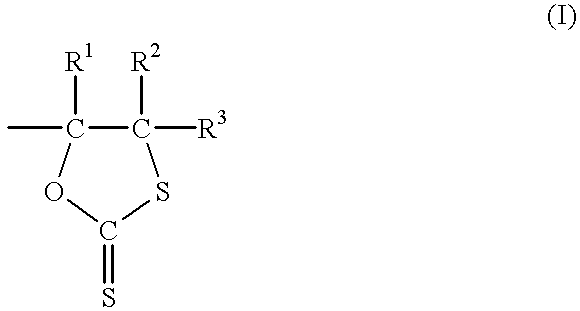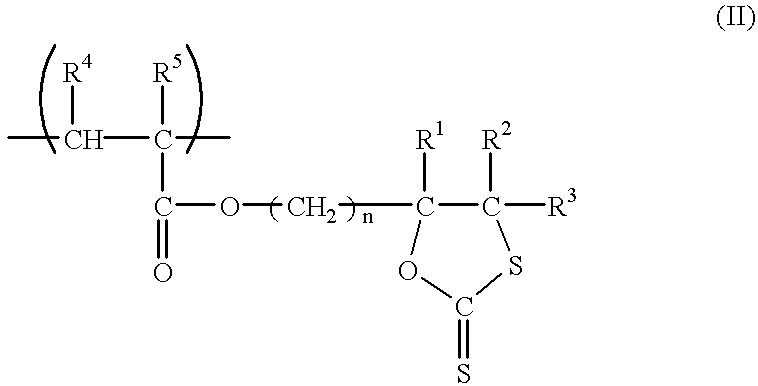Dithiocarbonate composition
a technology of dithiocarbonate and composition, applied in the field of dithiocarbonate composition, can solve the problems of not revealing a detailed method of polymerization, unable to use compositions described in these publications as one-liquid type coatings or adhesives, and unable to express values of physical properties, etc., to achieve the effect of improving the appearan
- Summary
- Abstract
- Description
- Claims
- Application Information
AI Technical Summary
Benefits of technology
Problems solved by technology
Method used
Image
Examples
reference example 2
(Resin: A-2)
A flask equipped with a dropping device, a stirrer, a thermometer, a condenser, and a nitrogen gas introduction tube was charged with 150 g of methyl isobutyl ketone. The flask was heated to 100.degree. C., and then purged with nitrogen. Subsequently, a liquid mixture of 19.6 g of glycidyl methacrylate, 128.9 g of butyl methacrylate, and 1.5 g of t-butyl peroxy-2-hexanoate was added dropwise into the flask over 3 hours. The polymerization was completed after maturation at 100.degree. C. for 3 hours to yield a resin having a solid content of 50% by weight and a weight-average molecular weight of 22,000 (resin: A-2).
reference example 3
(Resin: A-1)
A 10-L flask equipped with devices similar to those used in Reference Example 1 was charged with 5 L of tetrahydrofuran, 500 g of bisphenol A-epichlorohydrin type epoxy resin ("E-1001", manufactured by Yuka Shell Epoxy Kabushiki Kaisha), and 25 g of lithium bromide, which were stirred well. Then, 340 mL of carbon disulfide was added dropwise to the solution in such a manner that the temperature of the solution reaches 25.degree. C., and thereafter the flask was heated to 45.degree. C., and the reaction was allowed to proceed for 8 hours.
After the reaction, the reaction liquid was concentrated under reduced pressure. To the concentrated residue obtained, 5 L of chloroform and 3 L of water was added, and separation of the liquid was performed. To the organic phase which was taken out, 500 L of saturated saline solution was added, and separation of the liquid was performed again. The organic phase obtained was dehydrated using 300 g of magnesium sulfate, and thereafter chlo...
reference example 4
(Resin: A-4)
A flask equipped with a stirrer, a thermometer, a nitrogen gas introduction tube, and a dropping funnel was charged with 200 g of butyl cellosolve, and heated to 100.degree. C. A liquid mixture of 60 g of (methacryloyloxy)methyl-1,3-oxathiolane-2-thione, 26 g of acryllic acid, 294 g of butyl methacrylate, and 20 g of 2,2-azobis-2-methylbutyronitrile was added dropwise from the dropping funnel into the flask over 3 hours. After completion of the dropwise addition, maturation was allowed to take place for 3 hours at the same temperature. After cooling, 32 g of triethylamine and 35 g of water were added to yield the intended resin (resin: A-4). The resin solution obtained had a solid content of 60% by weight and a weight-average molecular weight of 10,000 (resin: A-4).
PUM
| Property | Measurement | Unit |
|---|---|---|
| temperature | aaaaa | aaaaa |
| temperature | aaaaa | aaaaa |
| temperature | aaaaa | aaaaa |
Abstract
Description
Claims
Application Information
 Login to View More
Login to View More - R&D
- Intellectual Property
- Life Sciences
- Materials
- Tech Scout
- Unparalleled Data Quality
- Higher Quality Content
- 60% Fewer Hallucinations
Browse by: Latest US Patents, China's latest patents, Technical Efficacy Thesaurus, Application Domain, Technology Topic, Popular Technical Reports.
© 2025 PatSnap. All rights reserved.Legal|Privacy policy|Modern Slavery Act Transparency Statement|Sitemap|About US| Contact US: help@patsnap.com



